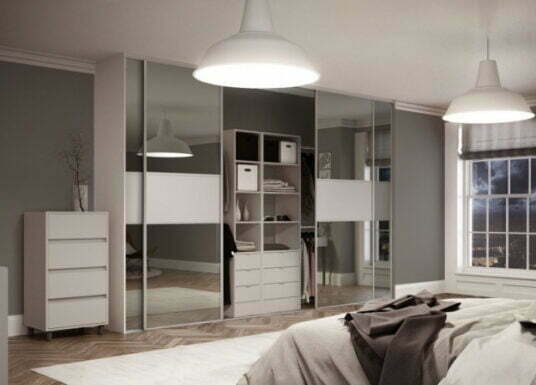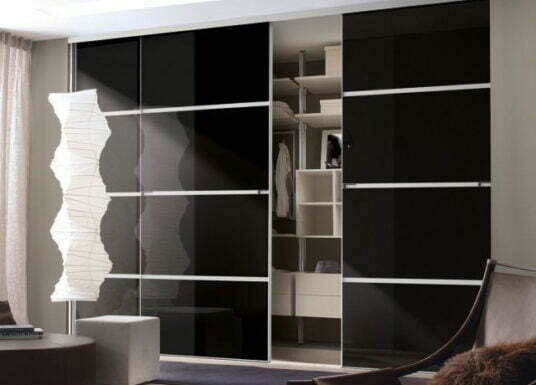How To Remove Fitted Wardrobes?
Removing fitted wardrobes can significantly change the layout and functionality of your room, providing new space and the opportunity for fresh interior design ideas. Whether your fitted wardrobes are outdated, damaged, or simply no longer match your vision for your room, undertaking their removal can refresh your living area.
Although it might appear challenging initially, you can achieve a successful removal without professional help by approaching the task systematically. Better yet, once your old wardrobe has been removed and disposed of, you can install a new sliding wardrobe supplied by our team at Sliding Robes Direct!
Why not browse our collection once you have read this article?
Do You Know The Safety Precautions?
Before beginning the removal of fitted wardrobes, it’s essential to ensure your safety and protect your property from potential damage. First, disconnect or switch off electricity within the room or area, as hidden wiring behind fitted wardrobes could pose risks. Use a circuit tester to confirm that the power has been disconnected.
Wear protective gear, such as gloves to protect your hands from splinters and sharp objects, safety glasses to shield your eyes from debris, and sturdy footwear to protect your feet from dropped items or sharp materials.
It’s also essential to keep children and pets away from the workspace to prevent accidents. Inform other household members about the planned work to avoid interference or unexpected hazards.
Do You Have The Right Tools Required?
As with any DIY project, having the correct tools is critical for efficiency and ease. Gather essential tools such as a screwdriver (manual and electric), pry bar, claw hammer, power drill, utility knife, crowbar, tape measure, and a ladder if your wardrobes extend significantly in height. To manage debris immediately, consider keeping a dustpan, brush, or vacuum cleaner nearby, and maintain a clean and safe workspace.

Step-by-Step Guide To Removing Fitted Wardrobes
Step 1: Clear the Wardrobe
Empty the wardrobe before dismantling any part. This includes clothing, accessories, shoes, and any other personal belongings. Remove any shelves, drawers, clothing rails, or removable organisers without tools. This step reduces weight, simplifies further dismantling, and prevents accidental damage to items left inside.
Step 2: Detach Doors and Hinges
Begin dismantling by removing wardrobe doors. Start with the hinges, using either a screwdriver or a power drill for efficiency. Unscrew each hinge slowly and carefully to avoid accidental damage to the doors or walls. Once the doors are detached, set them aside carefully, especially if you plan to reuse or sell them. Handle mirrored or glass panels cautiously, safely storing them to prevent breakage and injury.
Step 3: Remove Interior Fixtures
After removing the doors, proceed with internal fixtures. Fixed shelves, rails, or built-in drawers will typically be screwed or attached directly to the wardrobe’s framework. Use your screwdriver or power drill to remove screws and carefully lift each component out. Avoid using excessive force to prevent damage to adjacent areas. Label any components clearly if you plan to reuse or recycle them.
Step 4: Dismantle the Frame
The frame of a fitted wardrobe usually represents the most significant part and may be secured tightly to walls, ceilings, or floors. Begin this stage by loosening the frame from the wall edges using your pry bar or crowbar. Insert the tool carefully behind the wardrobe edges, gently prying away the structure while working methodically around the frame. Patience is critical here; excessive force may cause significant wall or ceiling damage. When dismantling wardrobes fitted against plasterboard or drywall, these surfaces can easily crack or crumble.
Step 5: Remove the Base and Back Panels
Once the frame has been detached from the surrounding walls, focus on the base and back panels. Often, these panels are secured with nails, screws, or adhesive. Use your pry bar, hammer, or screwdriver to detach these panels carefully. For stubborn panels secured by adhesive, gently sliding a utility knife around the edges can help release them without causing extensive damage to walls or floors. Again, caution and patience during this step will save time and effort in subsequent repairs.
Post-Removal Repair And Clean-up
After successfully removing your fitted wardrobe, the next step is assessing and repairing the exposed area. Inspect the walls, ceiling, and flooring for any damage caused during removal. Minor repairs may include filling holes with plaster or drywall filler, smoothing uneven surfaces with sandpaper, and painting to match the existing room décor.
If the wardrobe’s removal has exposed flooring that differs from the rest of the room, consider your options, such as matching new flooring, adding carpeting, or redesigning the area altogether. Thoroughly clean the workspace to remove dust, splinters, and other debris that could pose a hazard.

Disposal Or Recycling – Where Does Your Wardrobe Go?
Disposing or recycling materials from your removed wardrobe is essential for environmental sustainability. Many local recycling centers accept wood, metal, and glass. If parts of the wardrobe are in good condition, consider donating them to charity organisations, schools, or community centres or selling them online through marketplaces. Proper disposal of non-reusable components helps minimise environmental impact.
Do You Need To Order Another Wardrobe? Browse Our Collection At Sliding Robes Direct Today!
Removing fitted wardrobes is a manageable task when approached methodically and safely. It provides an excellent opportunity to reimagine and revitalise your living space. You can achieve professional-quality results by preparing adequately, utilising appropriate tools, working patiently, and carefully addressing post-removal repairs.
With proper planning, this DIY project can lead to satisfying improvements in your home’s functionality and aesthetics.
Now that you have learnt how to remove your old wardrobe, are you ready to browse our collection of stunning sliding wardrobe doors? All of these are ready to be delivered directly to your front door, so you can build a new wardrobe in no time!

